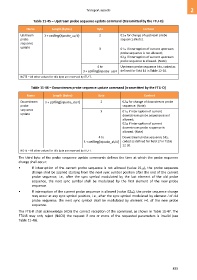Page 845 - 5G Basics - Core Network Aspects
P. 845
Transport aspects 2
Table 11-45 – Upstream probe sequence update command (transmitted by the FTU-O)
Name Length (bytes) Byte Content
Upstream 3 + ceiling(Nprobe_us/4) 2 0116 for change of upstream probe
probe sequence (Note).
sequence
update
3 0116 if interruption of current upstream
probe sequence is not allowed;
0216 if interruption of current upstream
probe sequence is allowed. (Note)
4 to Upstream probe sequence bits, coded as
3 + ceiling(Nprobe_us/4 defined for field 14 in Table 12-20.
NOTE – All other values for this byte are reserved by ITU-T.
Table 11-46 – Downstream probe sequence update command (transmitted by the FTU-O)
Name Length (bytes) Byte Content
Downstream 3 + ceiling(Nprobe_ds/4) 2 0216 for change of downstream probe
probe sequence. (Note)
sequence 3 0116 if interruption of current
update
downstream probe sequence is not
allowed;
0216 if interruption of current
downstream probe sequence is
allowed. (Note)
4 to Downstream probe sequence bits,
3 + ceiling(Nprobe_ds/4) coded as defined for field 17 in Table
12-20.
NOTE – All other values for this byte are reserved by ITU-T.
The third byte of the probe sequence update commands defines the time at which the probe sequence
change shall occur:
• If interruption of the current probe sequence is not allowed (value 0116), the probe sequence
change shall be applied starting from the next sync symbol position after the end of the current
probe sequence, i.e., after the sync symbol modulated by the last element of the old probe
sequence, the next sync symbol shall be modulated by the first element of the new probe
sequence.
• If interruption of the current probe sequence is allowed (value 0216), the probe sequence change
may occur at any sync symbol position, i.e., after the sync symbol modulated by element i of old
probe sequence, the next sync symbol shall be modulated by element i+1 of the new probe
sequence.
The FTU-R shall acknowledge (ACK) the correct reception of the command, as shown in Table 11-47. The
FTU-R may only reject (NACK) the request if one or more of the requested parameters is invalid (see
Table 11-48).
835

